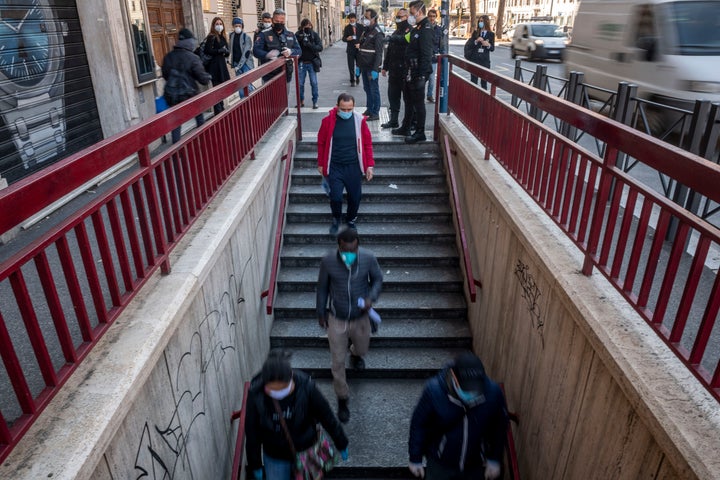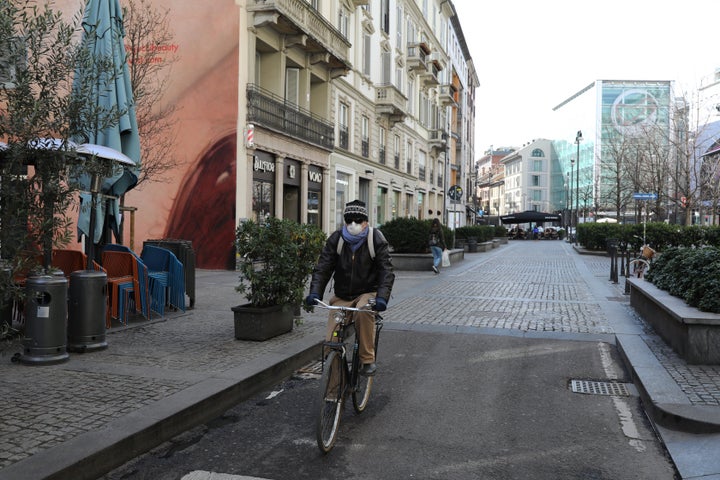As parts of Europe and the United States begin to lift coronavirus lockdown restrictions and allow people to go shopping, visit relatives and return to work, public officials are facing a new conundrum: How can people travel safely in crowded cities?
Italy is poised to serve as a major test case. On Sunday, Prime Minister Giuseppe Conte announced that many restrictions on daily life will be eased starting next Monday, but he warned that people would still need to avoid large gatherings, maintain social distancing and wear masks in certain circumstances.
“If we do not respect the precautions, the curve will go up, the deaths will increase and we will have irreversible damage to our economy,” Conte said in a televised address to the nation. “If you love Italy, keep your distance.”

Some 2.7 million Italians are expected to return to work next week, with 15% of them anticipated to use public transportation, according to Italian authorities.
Thus, government officials and business leaders are scrambling to develop protocols to allow people to move about freely without triggering a surge in coronavirus infections.
Under new guidelines that are being considered, the number of people allowed on buses and trains is likely to be restricted. Markers will be placed on the ground in metro stations to enforce social distancing, and camera systems and personnel will be deployed to help count passengers and prevent overcrowding, according to HuffPost Italy.
Italy’s transport ministry has suggested that electronic ticket machines will likely become standard, with hand sanitizer dispensers installed nearby. Trains and buses will be disinfected regularly, and the way passengers board and exit vehicles and stations will be adjusted. Moreover, a key goal of any plan will be to spread out daily commuters in order to reduce congestion.
Already, new measures are being tested in Rome. During a three-hour testing period on Friday, only 30 passengers were allowed into stations every three minutes at two of the city’s metro lines, and the number of passengers on each train was capped at 150, HuffPost Italy reported. On the train platforms, blue stripes with small dots indicated how far apart passengers needed to stand. Passages connecting the two lines were closed to prevent people from crossing each other and creating crowds.

In addition, many cities are hoping to encourage people to use alternate forms of transportation. Bologna has requested support from the federal government for the purchase of e-bikes and electric scooters, for example, and Milan has unveiled an ambitious plan to remake its streetscape to discourage car use and make it easier for people to walk and cycle, while still having room to spread out.
Over the summer, the city plans to take over 22 miles of streets and create temporary bike lanes and widened walkways for pedestrians. The speed limit for cars will be reduced in parts of the city, while bicycles and pedestrians will be given priority on certain streets.
“We worked for years to reduce car use. If everybody drives a car, there is no space for people, there is no space to move, there is no space for commercial activities outside the shops,” Milan’s deputy mayor, Marco Granelli, told The Guardian. “Of course we want to reopen the economy, but we think we should do it on a different basis from before. We think we have to reimagine Milan in the new situation.”
Other cities around the world are taking similar measures. This month, the city of Oakland, California, closed 74 miles of streets in order to allow people room to exercise outdoors while still maintaining social distancing. Bogota, Mexico City and Berlin have also added bike lanes.
Italy in particular, however, could provide a model for other cities to follow.
“The Milan plan is so important because it lays out a good playbook for how you can reset your cities now,” Janette Sadik-Khan, a former transportation commissioner for New York City, told The Guardian. “It’s a once-in-a-lifetime opportunity to take a fresh look at your streets and make sure that they are set to achieve the outcomes that we want to achieve: not just moving cars as fast as possible from point A to point B, but making it possible for everyone to get around safely.”
“I know we’ll be looking to Milan for guidance from New York City,” she added.
With reporting from HuffPost Italy.
- Stay up to date with our live blog as we cover the COVID-19 pandemic
- What happens if we end social distancing too soon?
- What you need to know about face masks right now
- How long are asymptomatic carriers contagious?
- Lost your job due to coronavirus? Here’s what you need to know.
- Everything you need to know about coronavirus and grief
- Parenting during the coronavirus crisis?
- The HuffPost guide to working from home
- What coronavirus questions are on your mind right now? We want to help you find answers.
- Everyone deserves accurate information about COVID-19. Support journalism without a paywall — and keep it free for everyone — by becoming a HuffPost member today.

